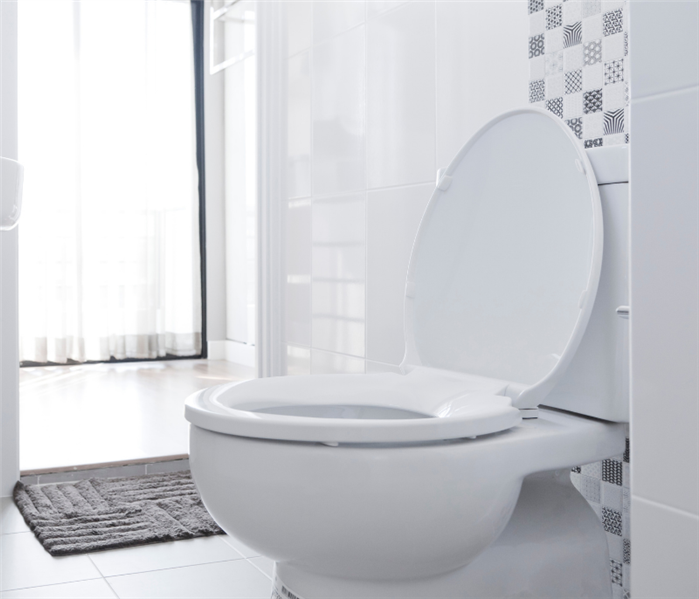Handling Water Damage From Overflowing Toilet
11/17/2020 (Permalink)
The water damage from a toilet overflow is something that most homeowners tend to overlook when it first happens. Many don't realize the extent of the damage until the toilet leaks through the bathroom floor and causes water stains to the ceiling below. Here, we will review everything you need to know about flooded toilets and water damage.
For immediate toilet overflow cleanup in Connecticut, call SERVPRO of Westport/Fairfield 24/7 - 203-707-1952
What Causes A Toilet To Overflow & How To Stop It
In order to stop the overflow and reduce the damage done to your home, you should understand the different reasons why toilets overflow. When you know the cause of your overflow, you'll be able to take the best course of action to stop the water as soon as possible and prevent a flooded bathroom.
Toilet Overflows After Flushing
When this happens, it means that the toilet drain is clogged and isn't allowing waste and toilet water to drain properly or the vent pipe is clogged. Many people have experienced this, and hopefully you can catch it before the water spills over the side of the toilet bowl and floods your home.
To stop the water from a clogged toilet drain, you can open the toilet tank and press down on the flapper valve to stop the flow of water to the toilet bowl. Then, lift the float to prevent the tank itself from refilling. These steps should stop the toilet from overflowing on to the bathroom floor and allow you to use a flange plunger to clear the clog.
Your toilet can also overflow after flushing because of the vent pipe. The vent pipe delivers the air needed for the toilet to properly flush. When this vent pipe is blocked, the toilet will not flush properly and be at risk of overflowing. This cause of an overflow is not something you can fix yourself - You'll have to call a plumber for help and not use the toilet until they arrive.
Toilet Overflows Without Flushing
If the water in your toilet keeps rising by itself, causing it overflow, you're likely dealing with a clog somewhere in the drain pipe of your plumbing system either in the main drain or sewer line. If you have a septic tank, the issue may also be that it is full. When this happens, your home is at risk of a sewage backup. This is because when the water exiting your house has nowhere to go because of a clog in the main line, it backflows to the lowest point in the system which is usually your toilet. This will cause it to repeated overflow without even flushing.
When the toilet water rises without flushing, the best thing to do is turn off the water supply line to the toilet, located on the wall directly behind it. You should also avoid using any water in your home until the blockage is cleared by a plumbing contractor, as it will have nowhere to go and backflow into your home.
Common Questions
What kind of water damage do toilet overflows cause?
Depending on where the affected bathroom is located in your home, there can be varying levels of damage.
- Water damage to drywall, flooring, and baseboards of bathroom
- Water damage and water stains on ceiling below bathroom
- Wet insulation
- Wet subfloor
- Structural deterioration
- Damaged electrical wiring
When you experience a toilet overflow that floods your bathroom, you should call in a water damage restoration company to inspect the damages and see what work needs to be done. When you just clean up standing water, you may be missing everything that has already seeped into the floor below that can cause major damage over time.
Is it safe to clean up a toilet overflow by yourself?
The answer to this depends on what type of water overflowed onto the bathroom floor. If the water was completely clear and clean from a toilet that overflowed without flushing, there should be no harm to you in cleaning it up yourself. But when a toilet overflows and contains water contaminated with urine, feces, or raw sewage - you should leave the cleanup to certified professionals. Contaminated water can make you extremely ill when you improperly handle it.
Toilet overflowed onto carpet?
Whenever a toilet overflows on to a carpet you should take the proper steps to have it cleaned, dried, and sanitized if possible. If it stays wet, the particles from toilet water may cause it to harbor harmful bacteria and produce mold growth.
Can a toilet overflow cause mold?
Yes, they can as any water damage event can produce mold in as little as 48 hours. That's why it's always best to act fast with flooded bathroom cleanup to prevent further damages to your home.





 24/7 Emergency Service
24/7 Emergency Service
